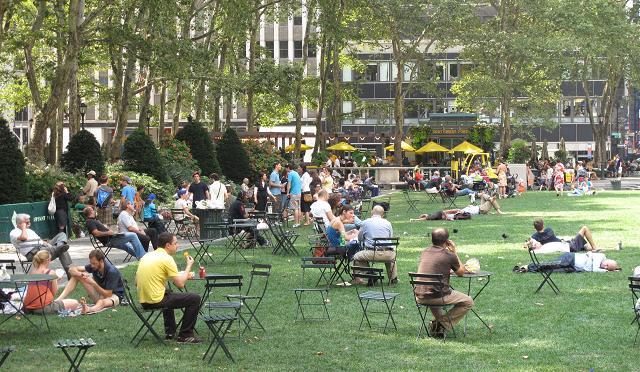In the hustle and bustle of everyday life, we often find solace and connection in places outside of work and home. Known as “The Third Place”, these communal areas serve as a sanctuary for relaxation, social interaction, and personal growth. Join us as we delve into the significance of these spaces and explore how they contribute to the fabric of our communities.
Table of Contents
- Exploring the Concept of The Third Place: A Home Away from Home
- Benefits of Having a Third Place: Social Connections and Mental Well-being
- Creating Your Own Third Place: Tips and Ideas for Design and Atmosphere
- Nurturing Community in The Third Place: Strategies for fostering inclusivity and belonging
- Q&A
- Wrapping Up

Exploring the Concept of The Third Place: A Home Away from Home
Imagine a space where you can escape the hustle and bustle of daily life, a place that is not work or home, but somewhere in between. This is the essence of the Third Place – a concept that has gained popularity in recent years. The Third Place is a sanctuary, a refuge from the chaos of the outside world. It is a place where you can relax, socialize, and be yourself.
Whether it’s a cozy cafe, a lively pub, or a community center, the Third Place is a home away from home. It is a place where you can unwind, connect with others, and forge new friendships. In our fast-paced society, the Third Place plays a crucial role in fostering a sense of belonging and community. It is a space where everyone is welcome, where conversation flows freely, and where memories are made.

Benefits of Having a Third Place: Social Connections and Mental Well-being
Having a designated “third place” outside of home and work can have numerous benefits for individuals, particularly in terms of social connections and mental well-being. This additional space allows people to foster relationships with others outside of their immediate circle, leading to a stronger sense of community and belonging.
By spending time in a third place, individuals can also improve their mental well-being by taking a break from the demands of everyday life and engaging in activities that bring them joy and relaxation. This separation from stressors can lead to decreased anxiety and an overall improved mood. In addition, the social interactions that occur in a third place can provide much-needed emotional support and a sense of camaraderie with others.

Creating Your Own Third Place: Tips and Ideas for Design and Atmosphere
When it comes to creating your own third place, the design and atmosphere play a crucial role in shaping the overall experience for your visitors. One tip to keep in mind is to focus on creating a welcoming and comfortable environment. This can be achieved through the use of cozy seating arrangements, warm lighting, and inviting decor elements such as plants or artwork. Additionally, consider incorporating elements that encourage social interaction, such as communal tables or cozy nooks for small groups.
To elevate the atmosphere of your third place, pay attention to the little details that can make a big difference. Consider playing background music that fits the vibe of your space, as well as offering a selection of beverages and snacks that cater to a variety of tastes. Another idea is to create a designated quiet area for those looking for a peaceful and focused environment. Ultimately, the key is to create a space that feels like a home away from home, where visitors can relax, socialize, and unwind.

Nurturing Community in The Third Place: Strategies for fostering inclusivity and belonging
In fostering a sense of inclusivity and belonging in the Third Place, it is essential to create a welcoming environment where all individuals feel valued and accepted. One strategy for achieving this is to offer a variety of programming and events that cater to the diverse interests and backgrounds of the community. By hosting workshops, classes, and social gatherings that appeal to a wide range of individuals, we can create opportunities for connection and shared experiences that foster a sense of belonging.
Another important strategy for nurturing community in the Third Place is to prioritize open communication and encourage active participation from all members. This can be achieved through the creation of feedback mechanisms, such as suggestion boxes or online forums, where individuals can voice their opinions and contribute to the decision-making process. By listening to and valuing the perspectives of all community members, we can create a culture of inclusivity and collaboration that strengthens the bonds within the Third Place.
Q&A
Q: What is “The Third Place”?
A: “The Third Place” is a term coined by sociologist Ray Oldenburg to describe a social setting outside of the home (the first place) and work (the second place) where people can gather, socialize, and feel a sense of community.
Q: What are some examples of “The Third Place”?
A: Examples of “The Third Place” include coffee shops, bookstores, community centers, parks, and other public spaces where people can come together to relax, connect, and engage with others.
Q: Why is “The Third Place” important?
A: “The Third Place” plays a crucial role in fostering a sense of belonging and social connection in communities. It provides a space for people to escape the pressures of work and home life, and allows for spontaneous interactions and collaborations to occur.
Q: How can individuals benefit from frequenting “The Third Place”?
A: By spending time in “The Third Place”, individuals can improve their mental well-being, build social connections, and find a support network outside of their immediate circles. It can also lead to increased creativity and productivity in other areas of their lives.
Q: How can communities promote the development of “The Third Place”?
A: Communities can support the creation of “Third Places” by investing in public spaces, hosting community events, and encouraging local businesses to provide welcoming environments for residents to gather and connect. Collaborative efforts between residents, businesses, and government can help to cultivate a strong sense of community and belonging.
Wrapping Up
As we delve deeper into the concept of “The Third Place”, it becomes evident that these spaces hold a special significance in our lives. They provide a sense of community, connection, and belonging that is difficult to find elsewhere. Whether it be a coffee shop, library, park, or pub, The Third Place plays a crucial role in fostering relationships and nurturing creativity. So next time you find yourself seeking a place to unwind and connect with others, remember the importance of valuing and supporting these unique environments. Embrace the magic of The Third Place, and watch as it enriches your life in ways you never imagined.










